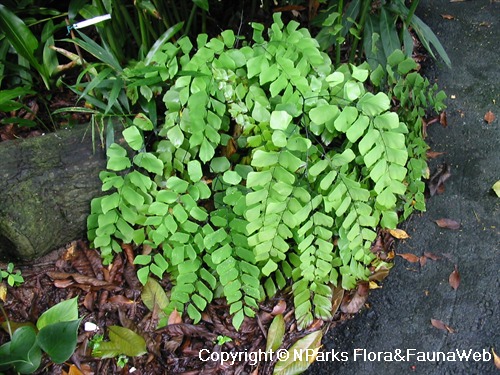
Back
Adiantum hispidulum Sw.
| Family Name: | Pteridaceae |
| Common Name: | Rough Maidenhair Fern, Rosy Maidenhair Fern, 糙毛铁线蕨 |
Name
Classifications and Characteristics
| Plant Division | Ferns & Lycophytes (Non-Seed Vascular Plants) (Fern) |
|---|---|
| Plant Growth Form | Herbaceous Plant |
| Mode of Nutrition | Autotrophic |
Biogeography
| Native Distribution | Polynesia, Africa, southern India, the Philippines, Malaysia, Indonesia (Java), Thailand, Taiwan, Australia, New Zealand, the Pacific Islands, USA |
|---|---|
| Native Habitat | Terrestrial |
| Preferred Climate Zone | Tropical |
| Local Conservation Status | Cryptogenic |
Description and Ethnobotany
| Growth Form | Small to medium-sized fern, able to grow up to 40 - 50 cm tall and with a spread of 30 - 50 cm wide. |
|---|---|
| Roots | Erect and short rhizomes covered with purplish-black scales. |
| Foliage | Dark green fronds are bipinnate to tripinnate, lamina reaching about 20 - 30 cm long; each frond is divided into 6 - 10 pinnae, (middle pinna usually the longest), and each pinna usually has 20 - 30 pairs of pinnules; sori usually 6 - 14 on the undersides of each pinnule, dark brown false indusia; stipe dark brown and measures about 20 cm long. |
| Etymology | Genus Adiantum is from the Greek word "adiantoj" which means "unwetted" and refers to the fronds being water-repellent. Species hispidulum means bristly with stiff hairs and refers to the hairy stems of the fern. |
Landscaping Features
| Desirable Plant Features | Ornamental Foliage |
|---|---|
| Landscape Uses | Parks & Gardens, Small Gardens, Vertical Greenery / Green Wall, Container Planting, Terrarium |
Plant Care and Propagation
| Light Preference | Semi-Shade |
|---|---|
| Water Preference | Moderate Water |
| Plant Growth Rate | Slow |
| Rootzone Tolerance | Well-Drained Soils |
| Propagation Method | Spore, Division |
Foliar
| Mature Foliage Colour(s) | Green |
|---|
Image Repository
Others
| Master ID | 32359 |
|---|---|
| Species ID | 6770 |
| Flora Disclaimer | The information in this website has been compiled from reliable sources, such as reference works on medicinal plants. It is not a substitute for medical advice or treatment and NParks does not purport to provide any medical advice. Readers should always consult his/her physician before using or consuming a plant for medicinal purposes. |



.jpg)

